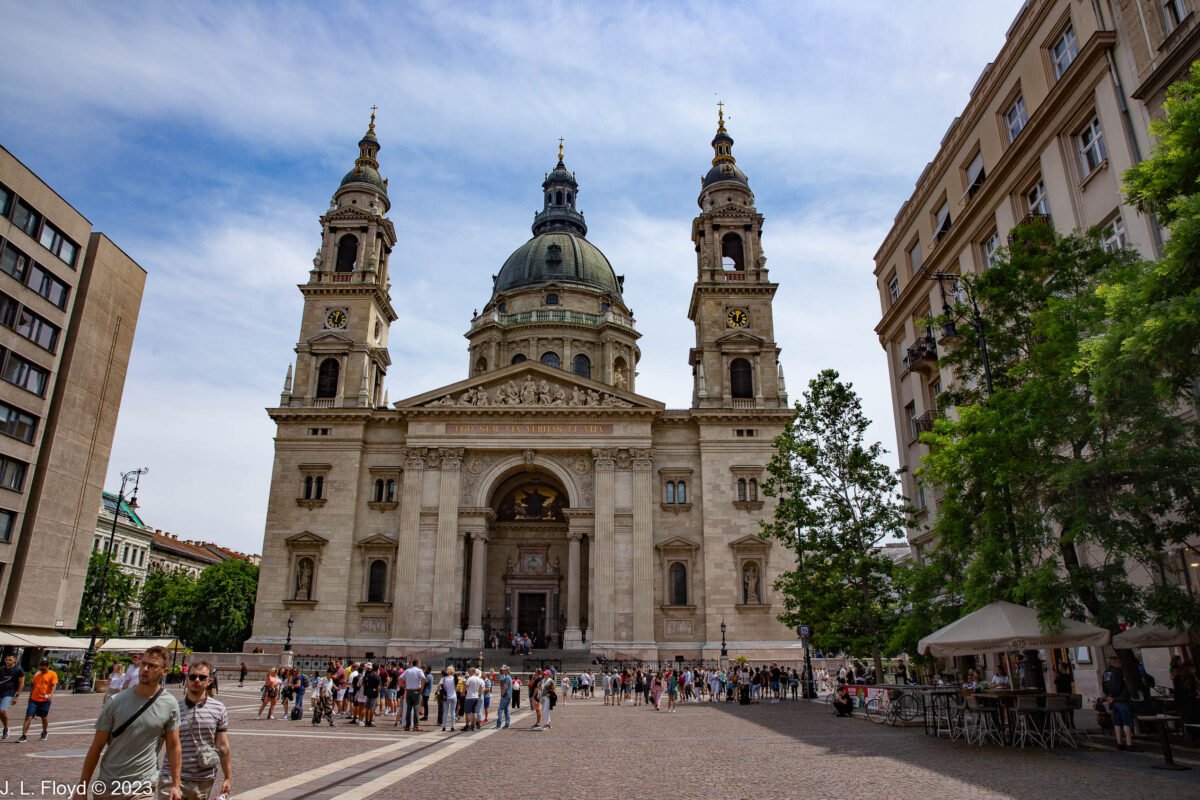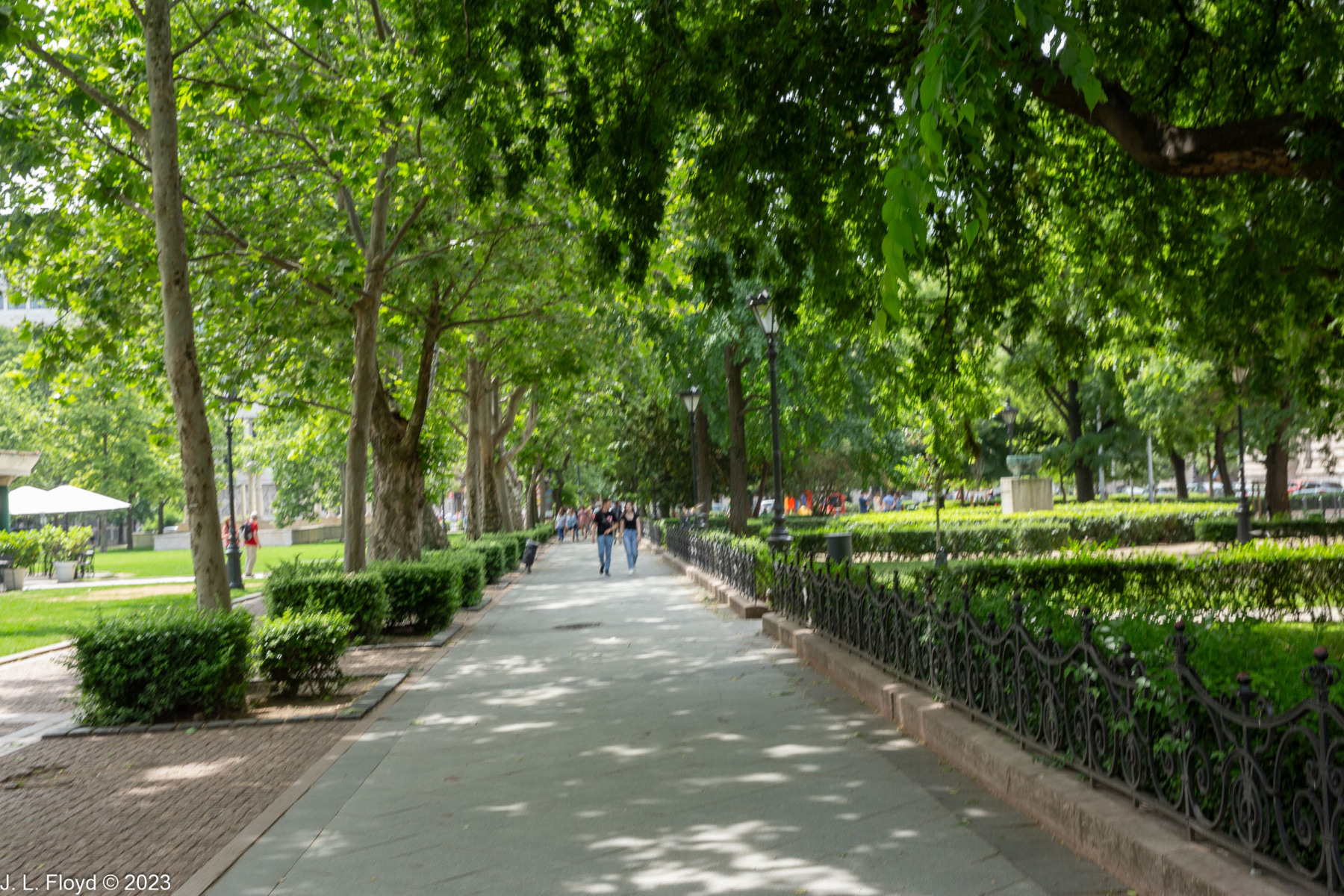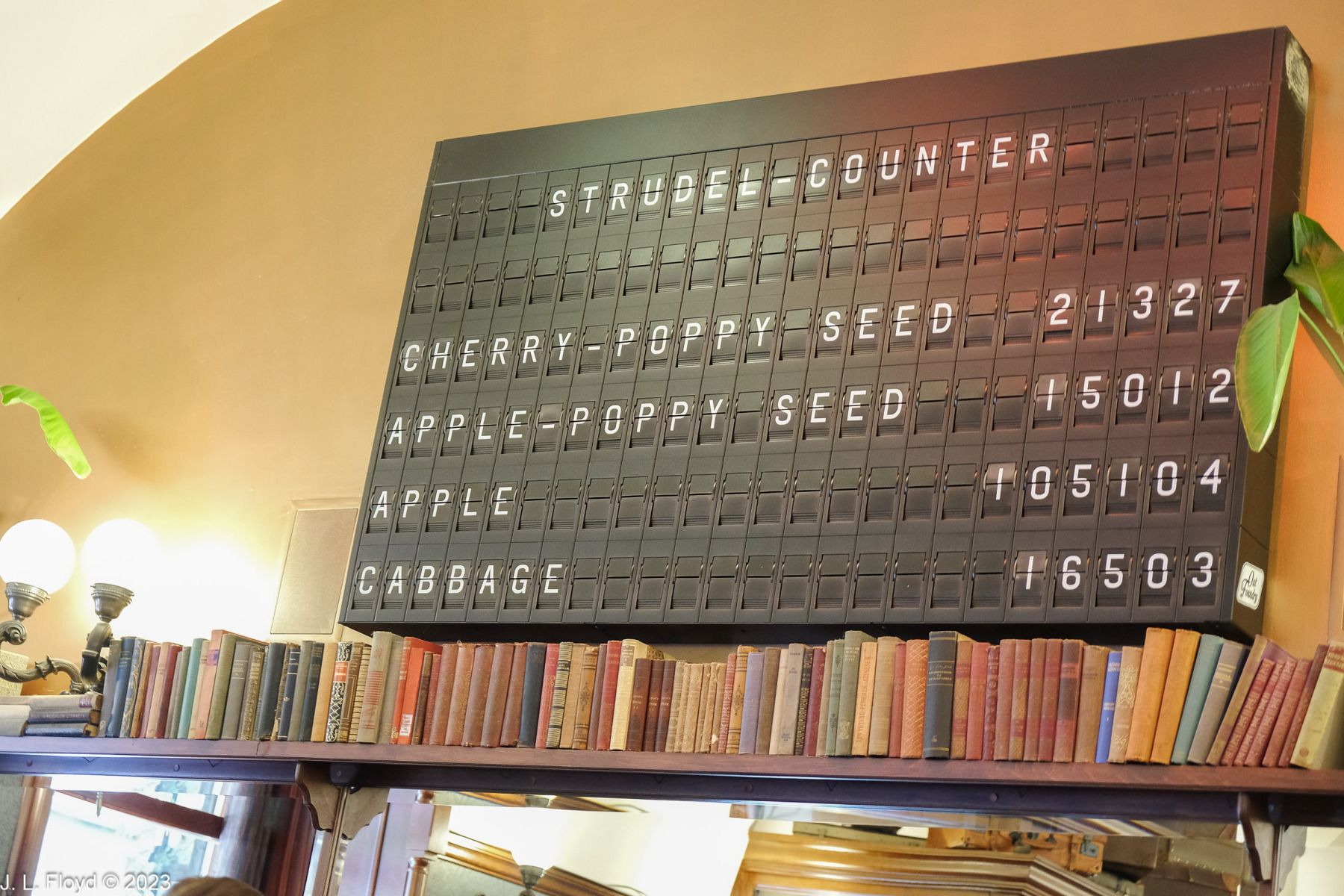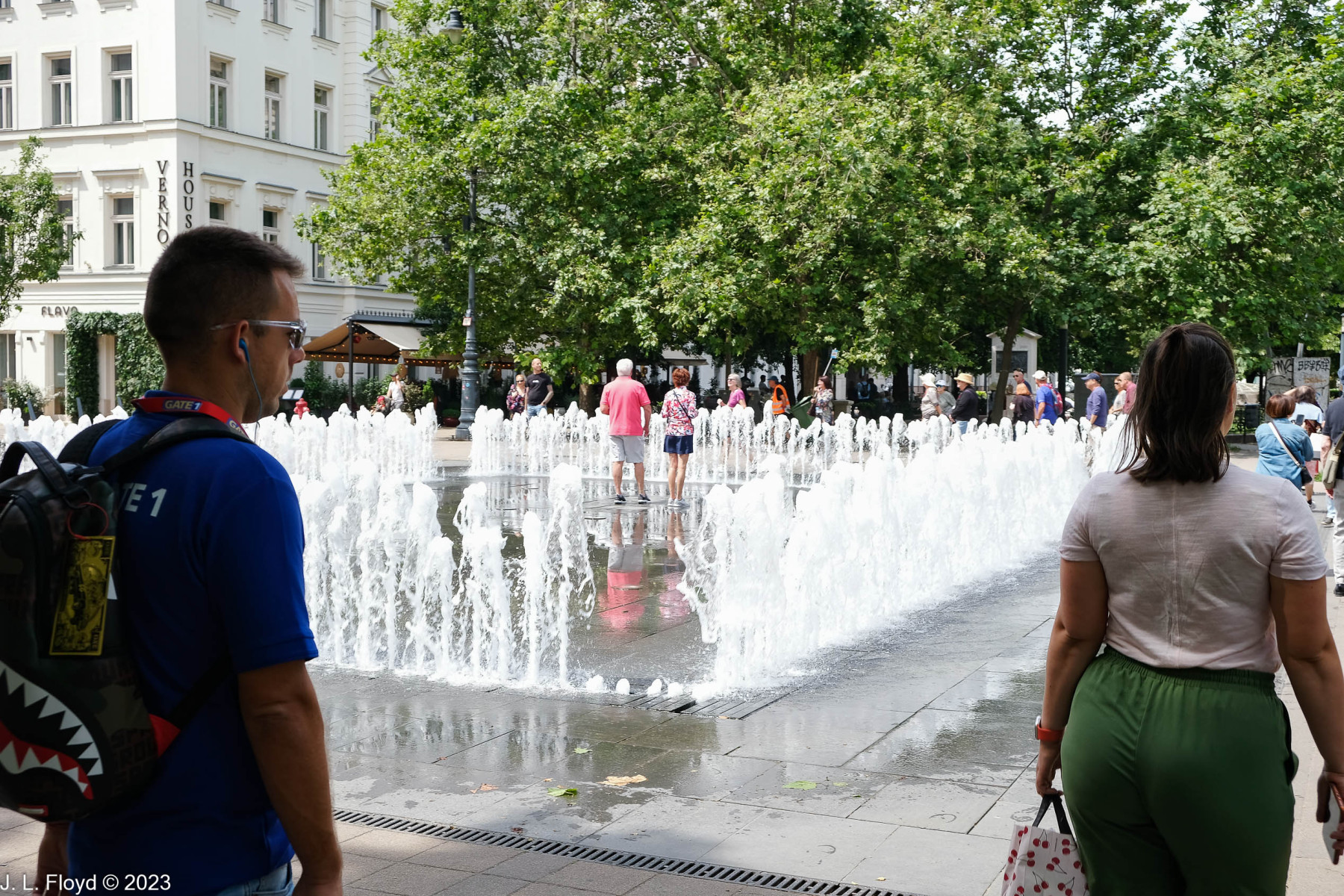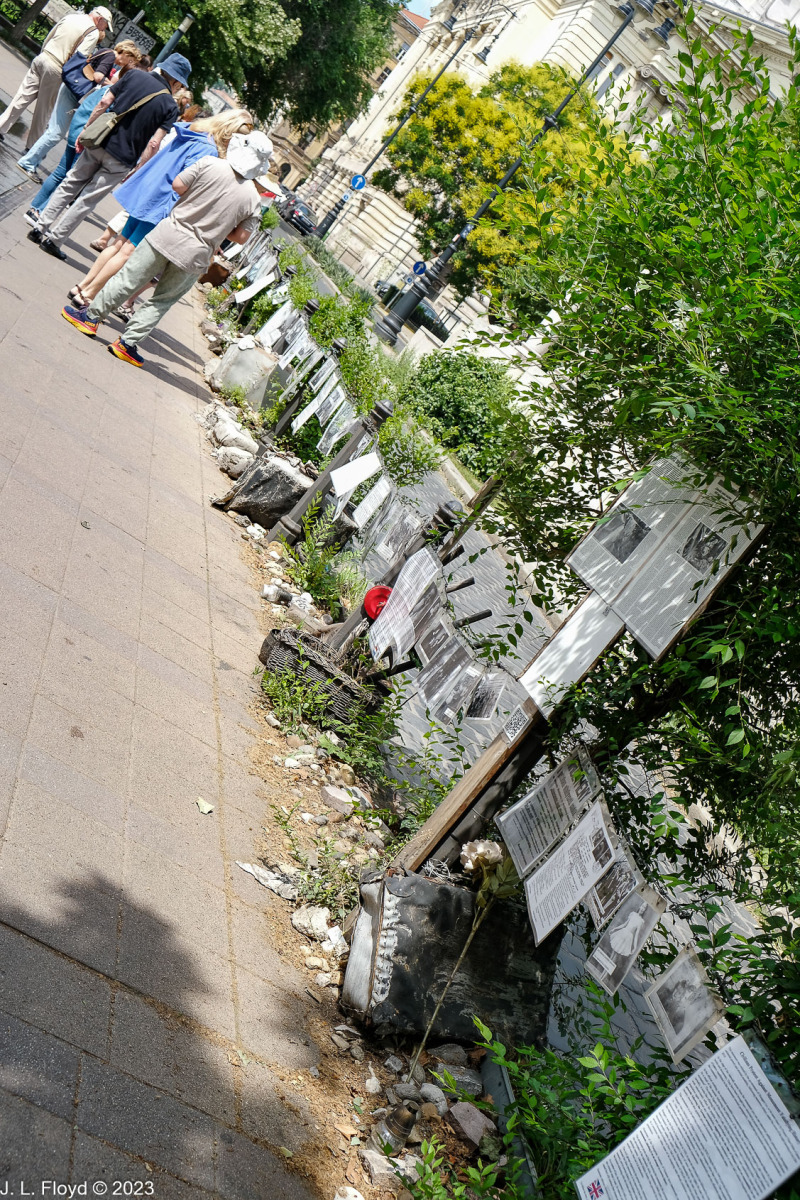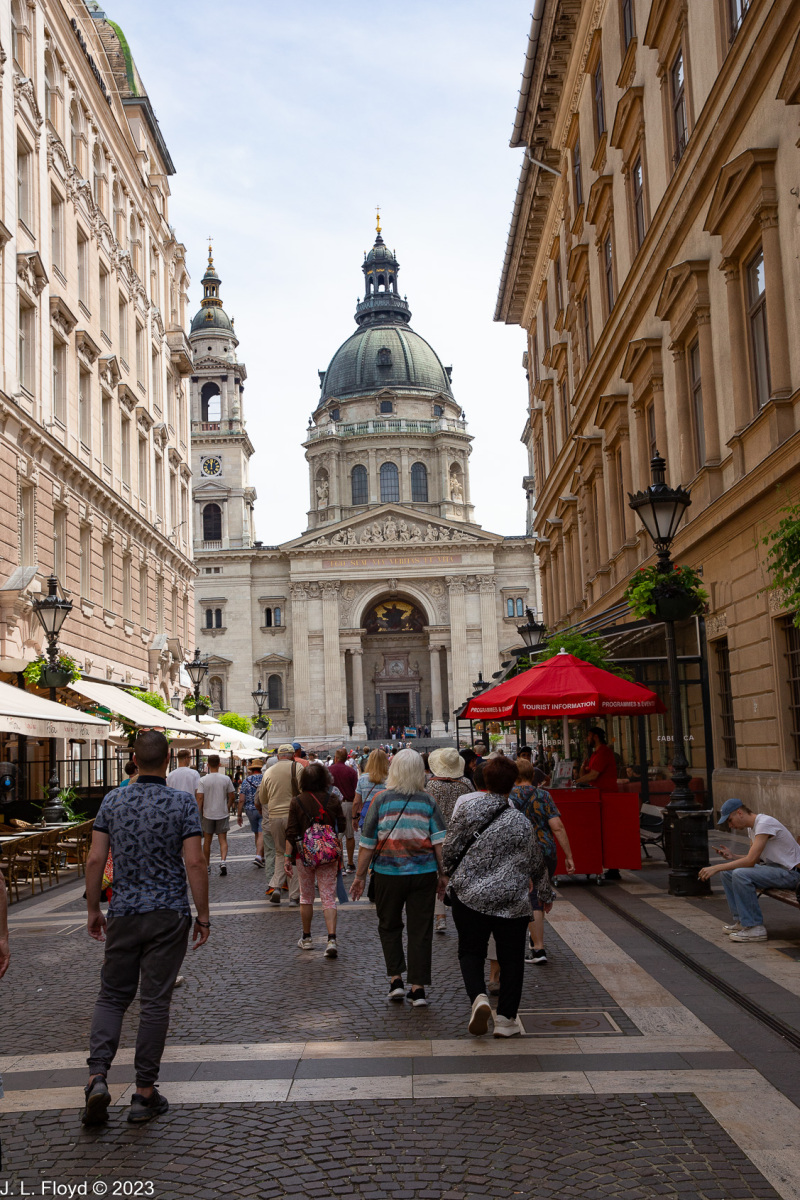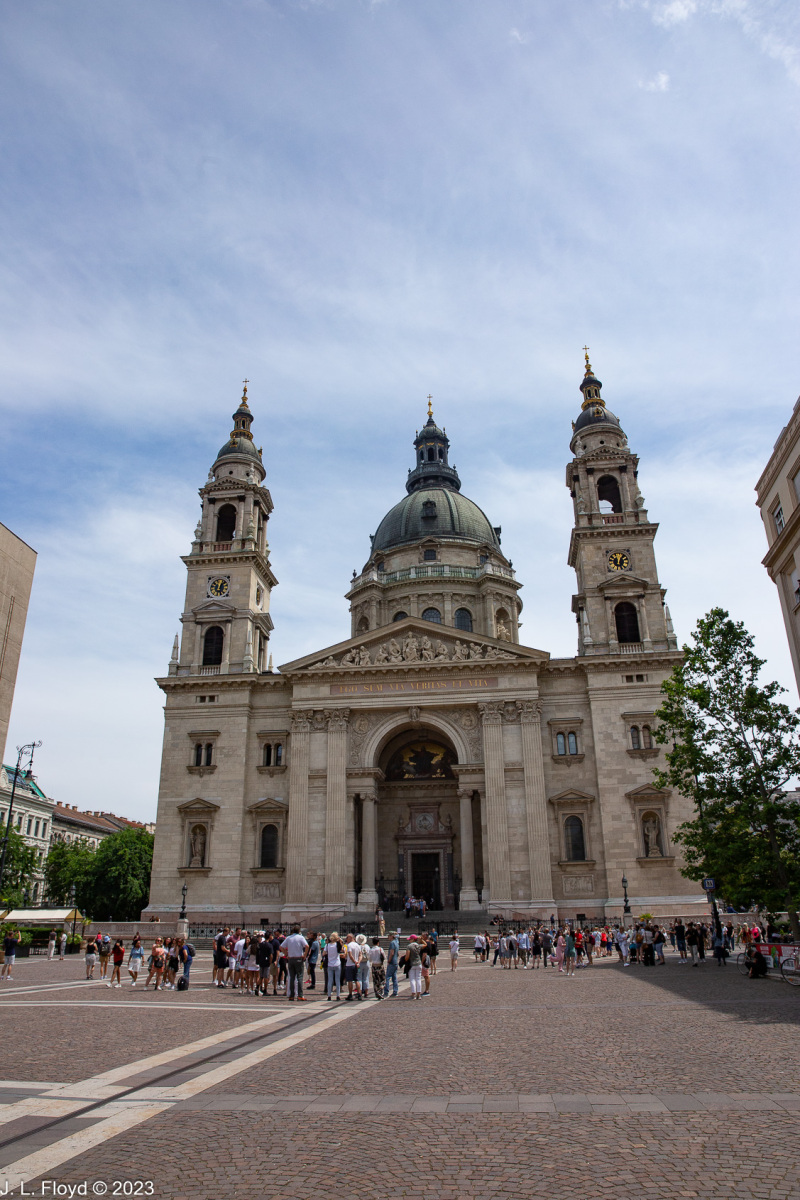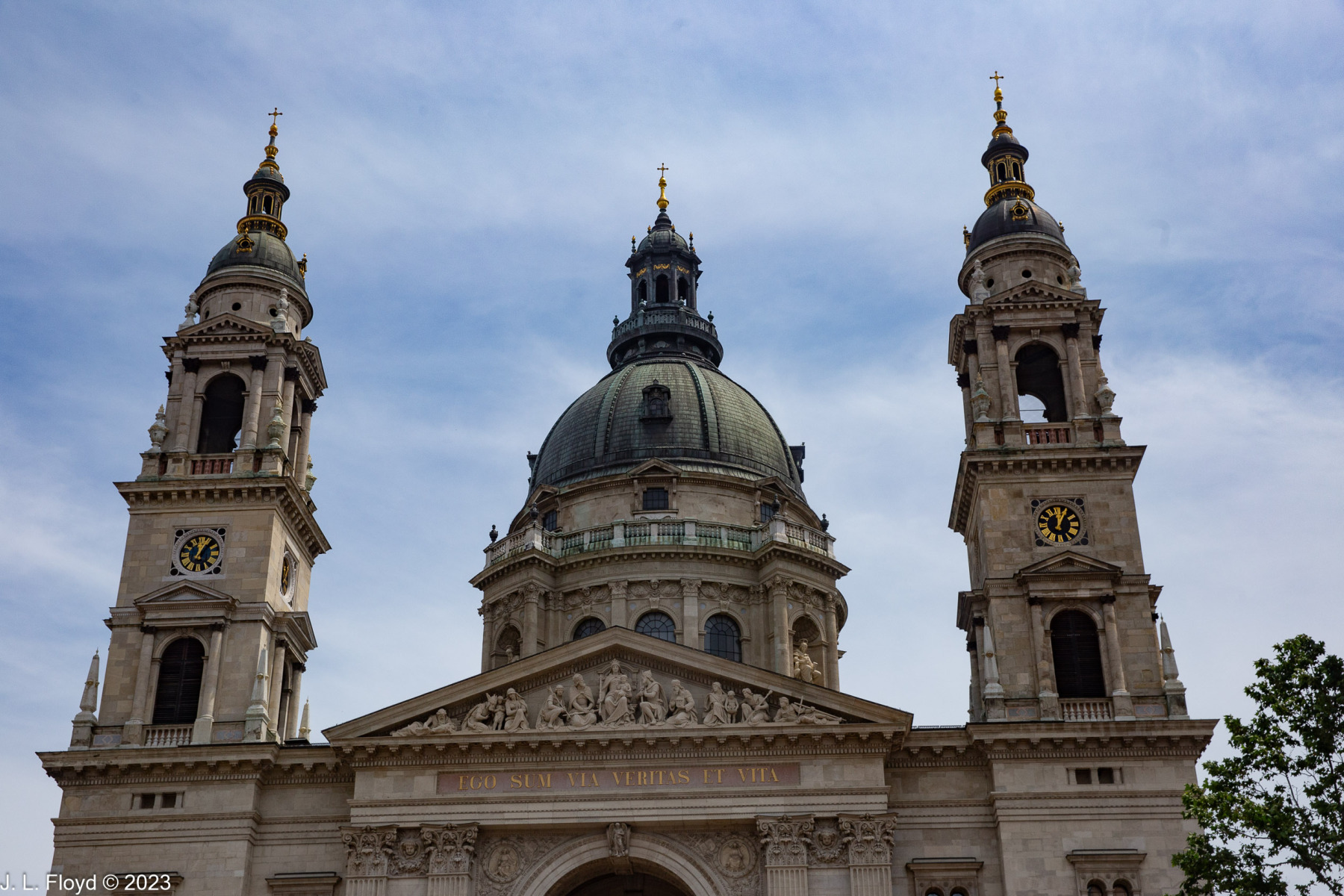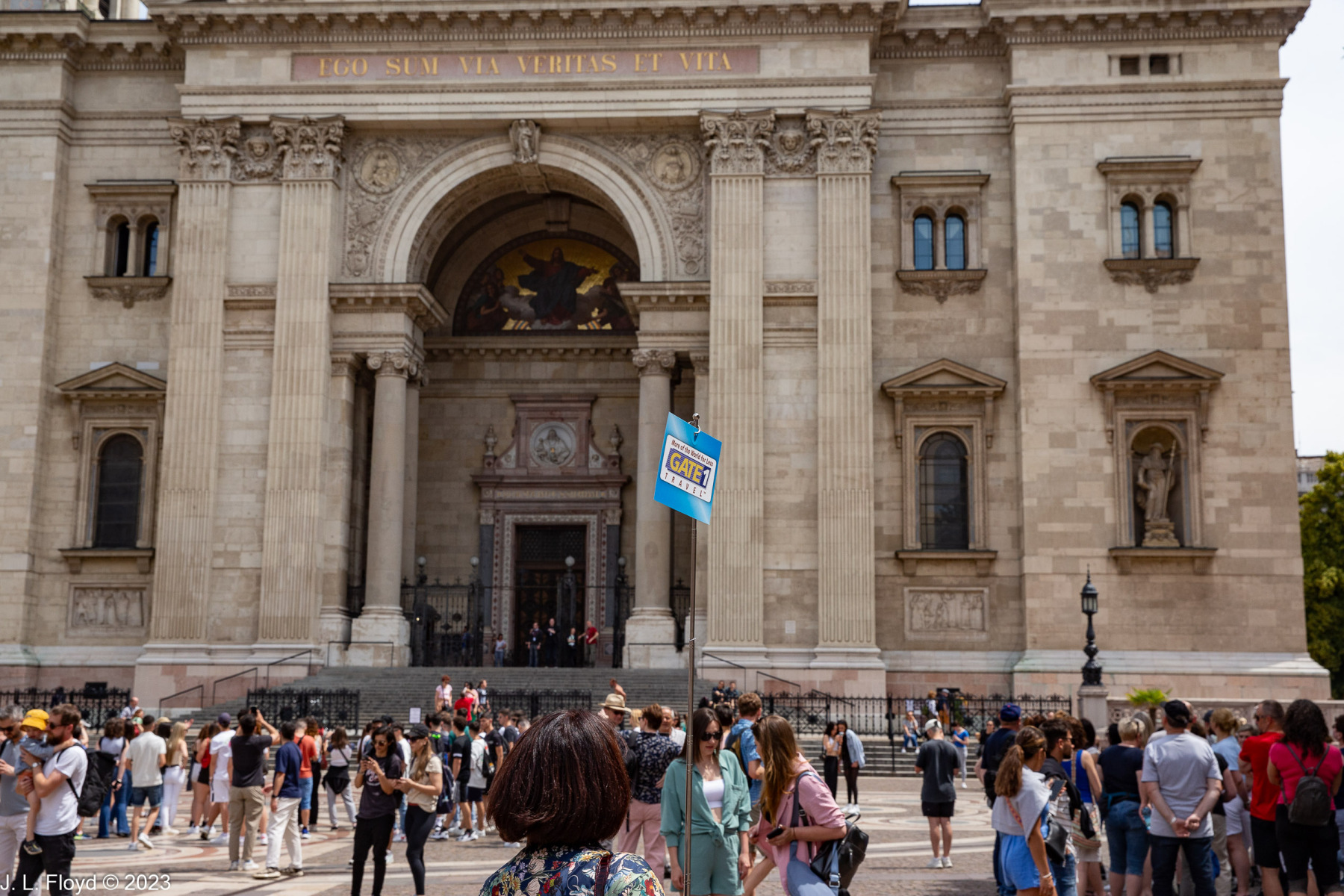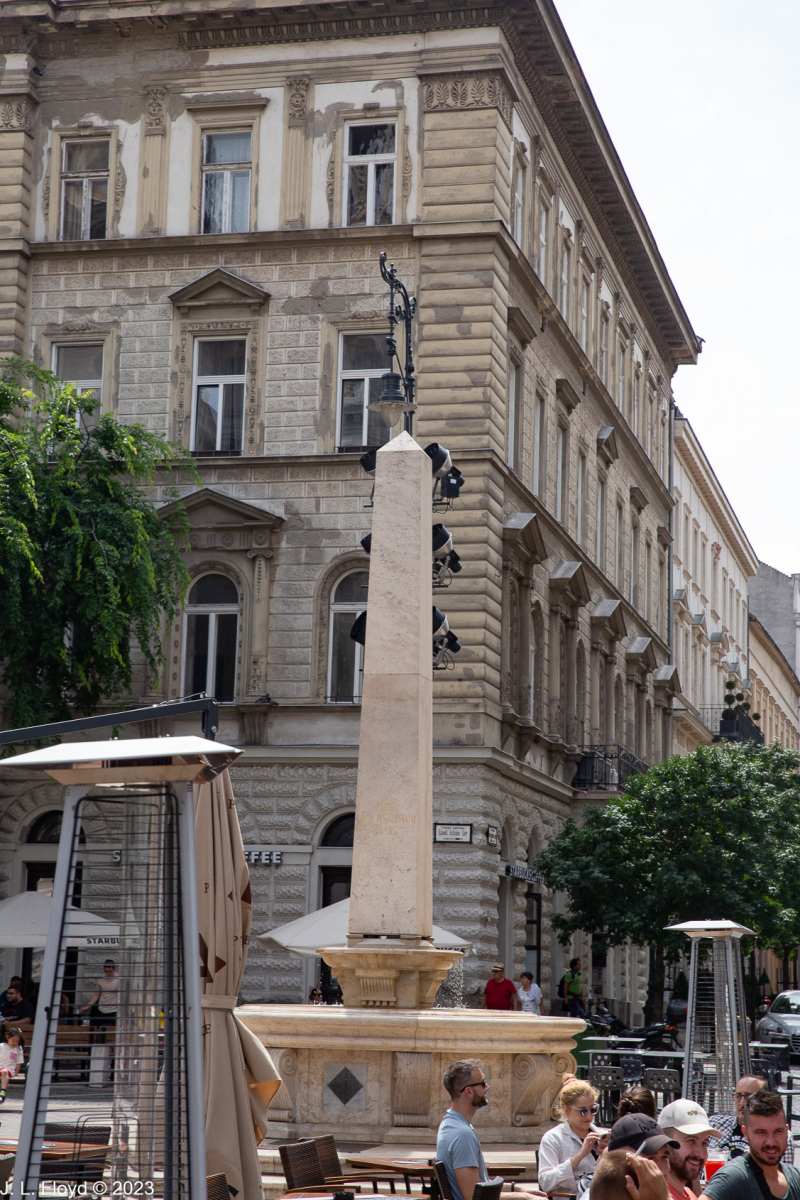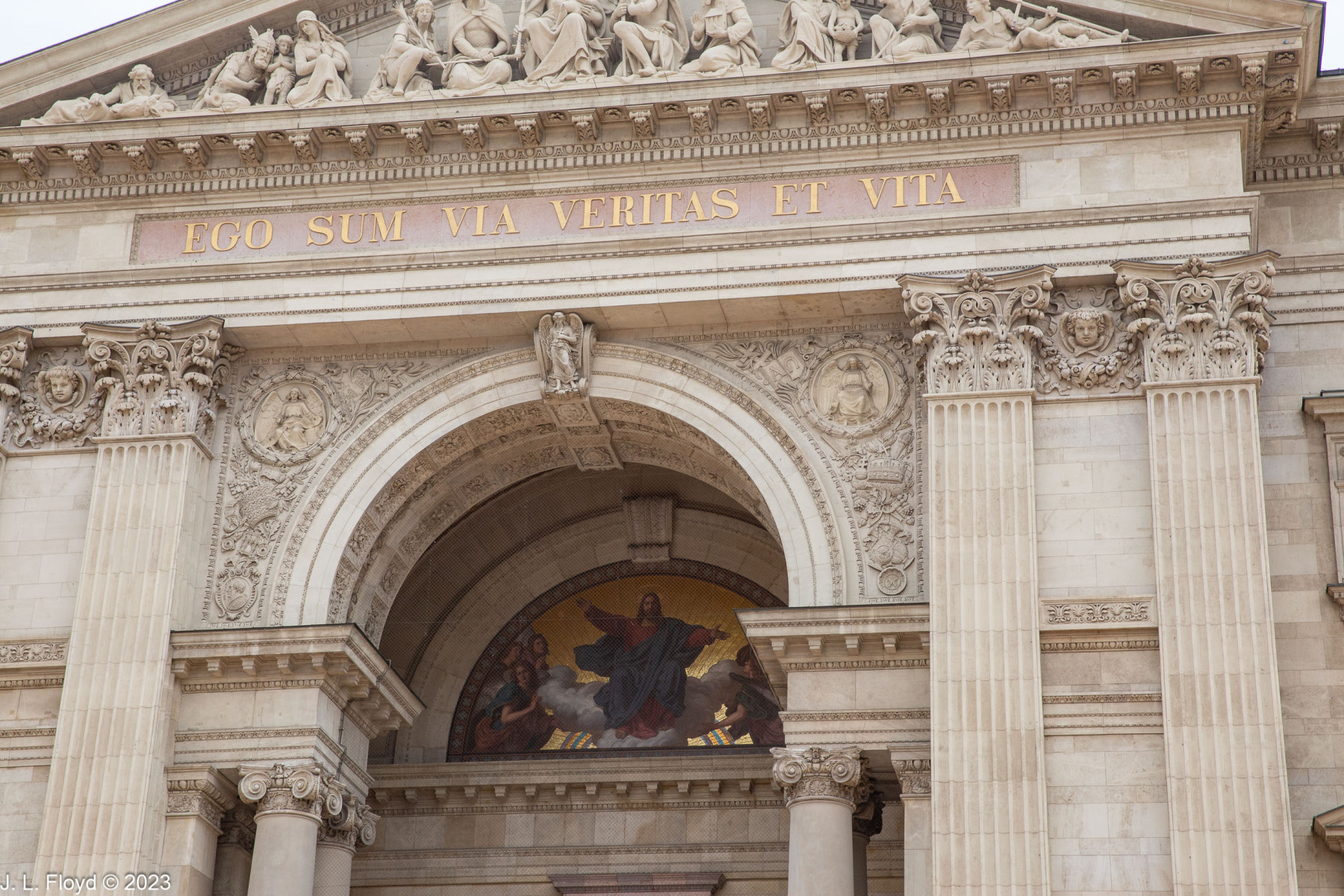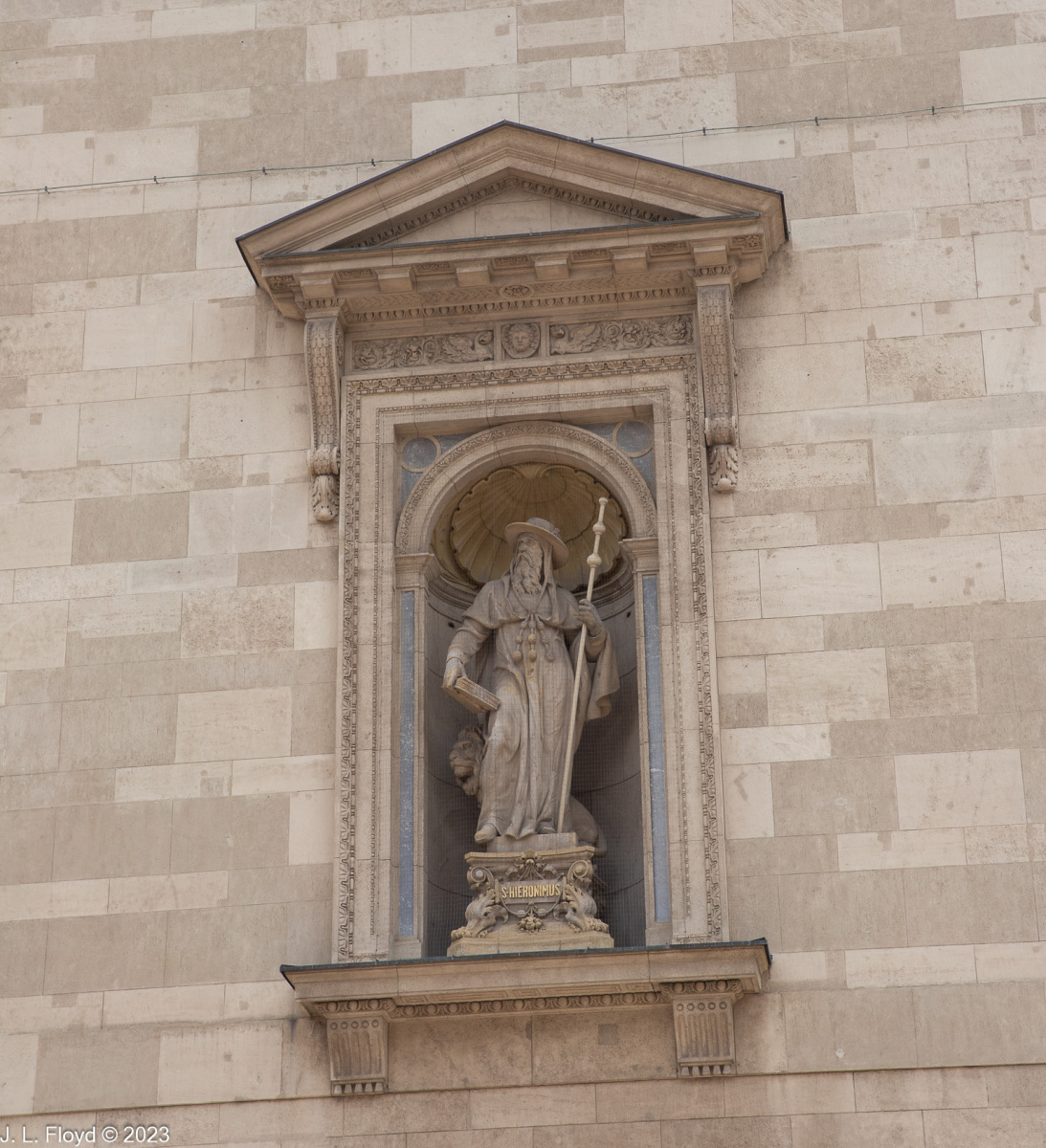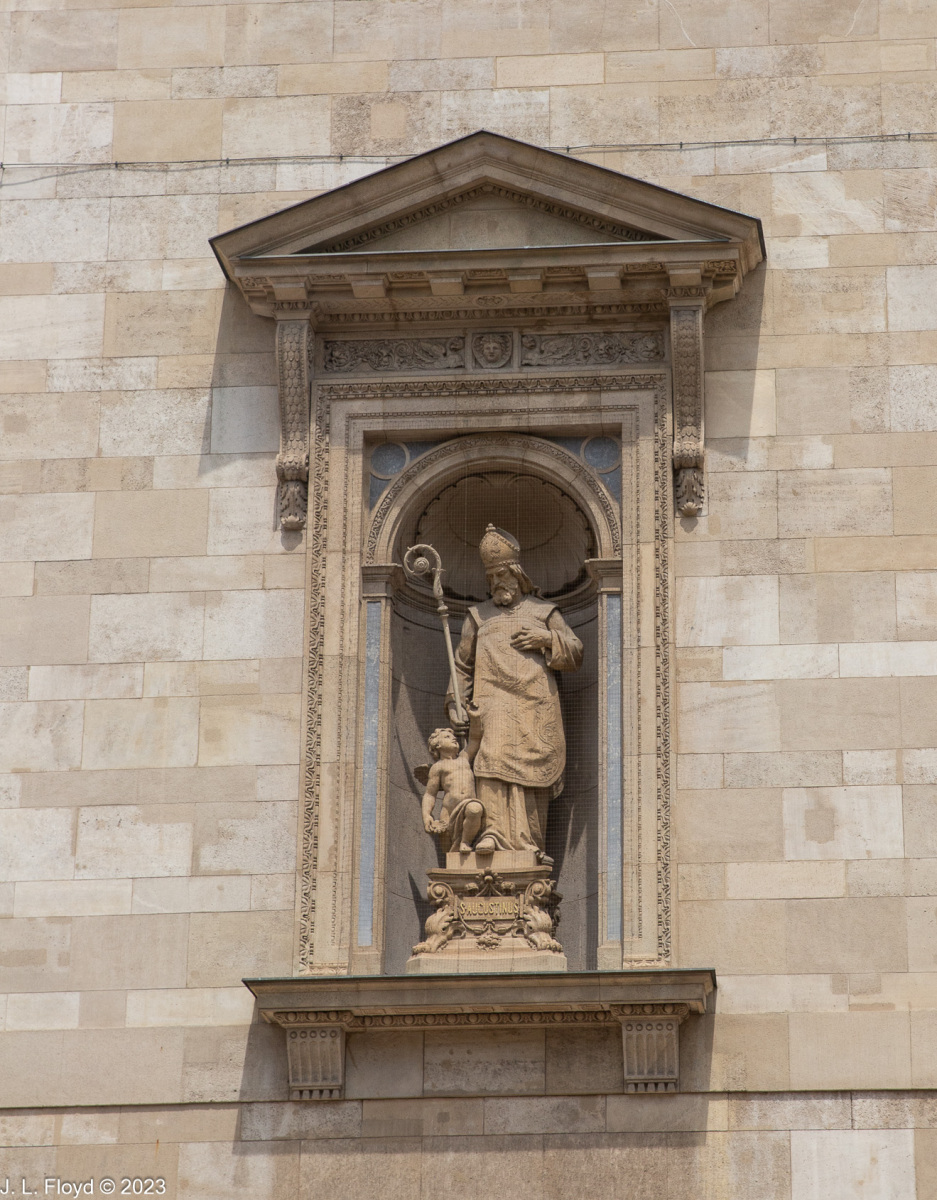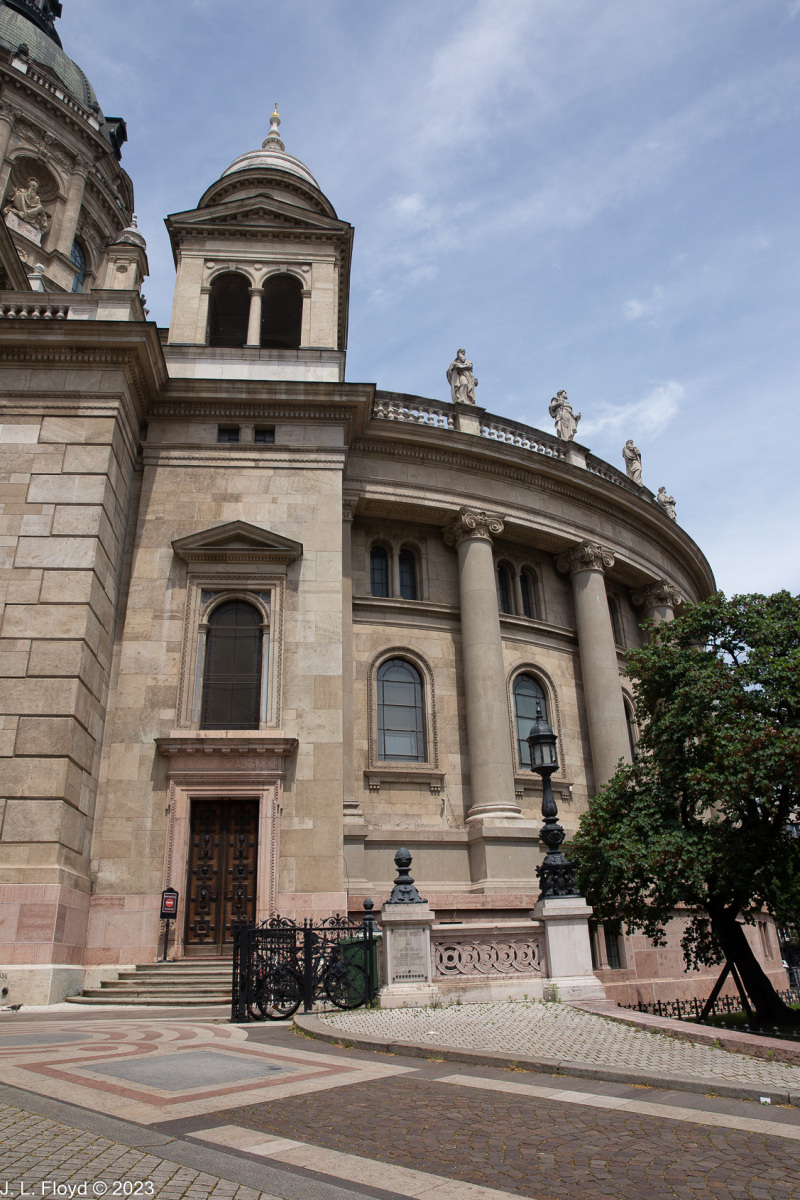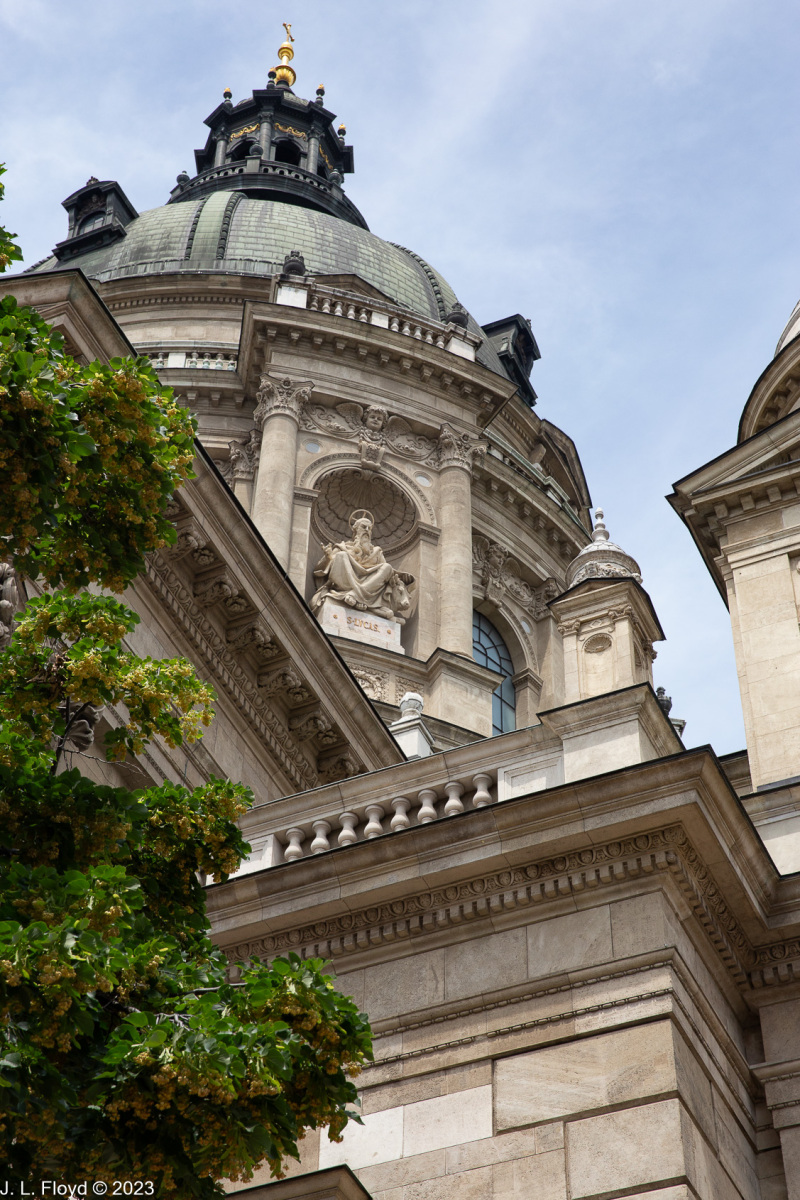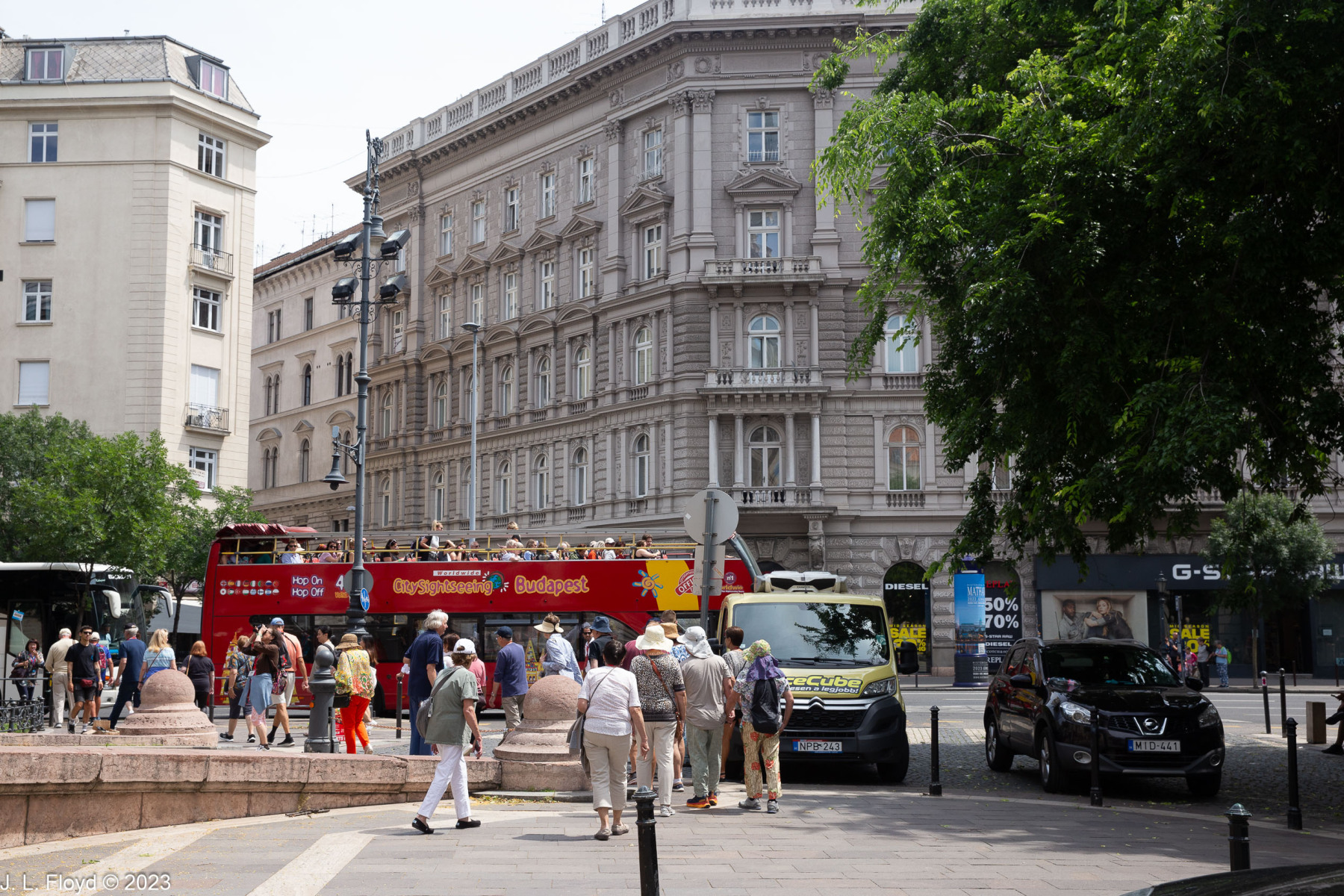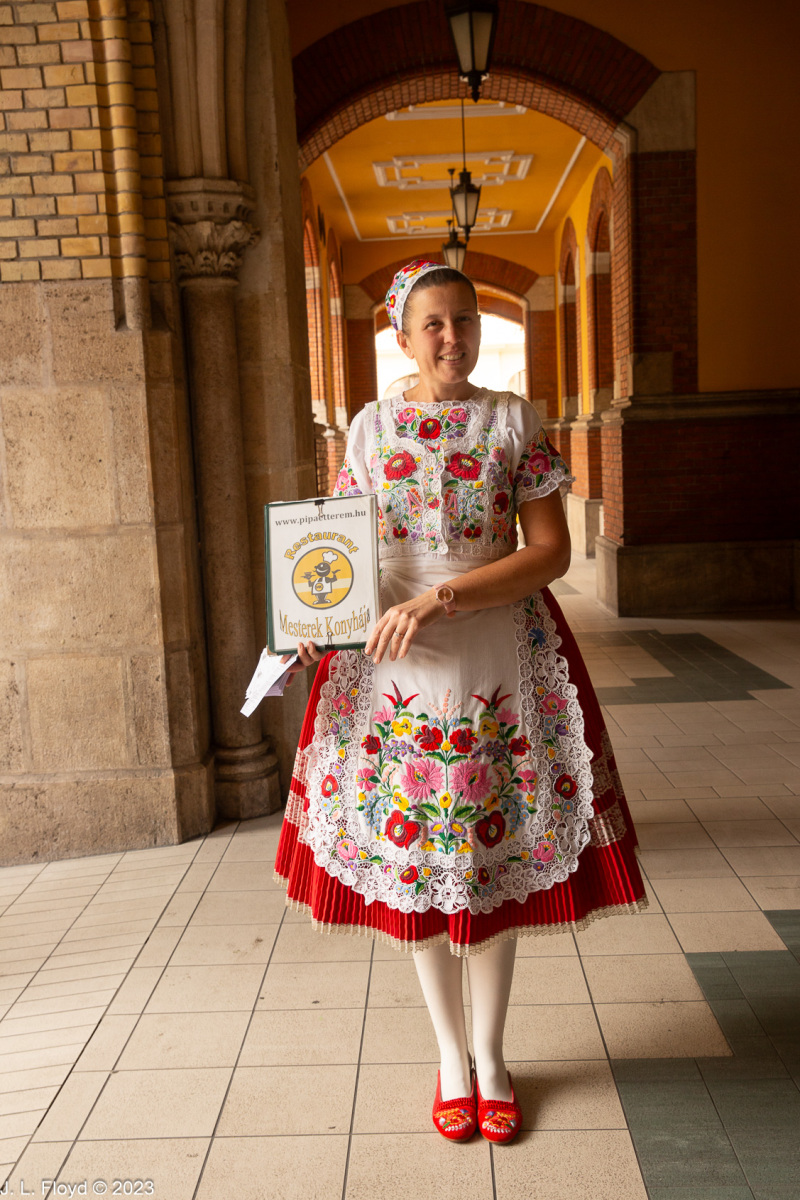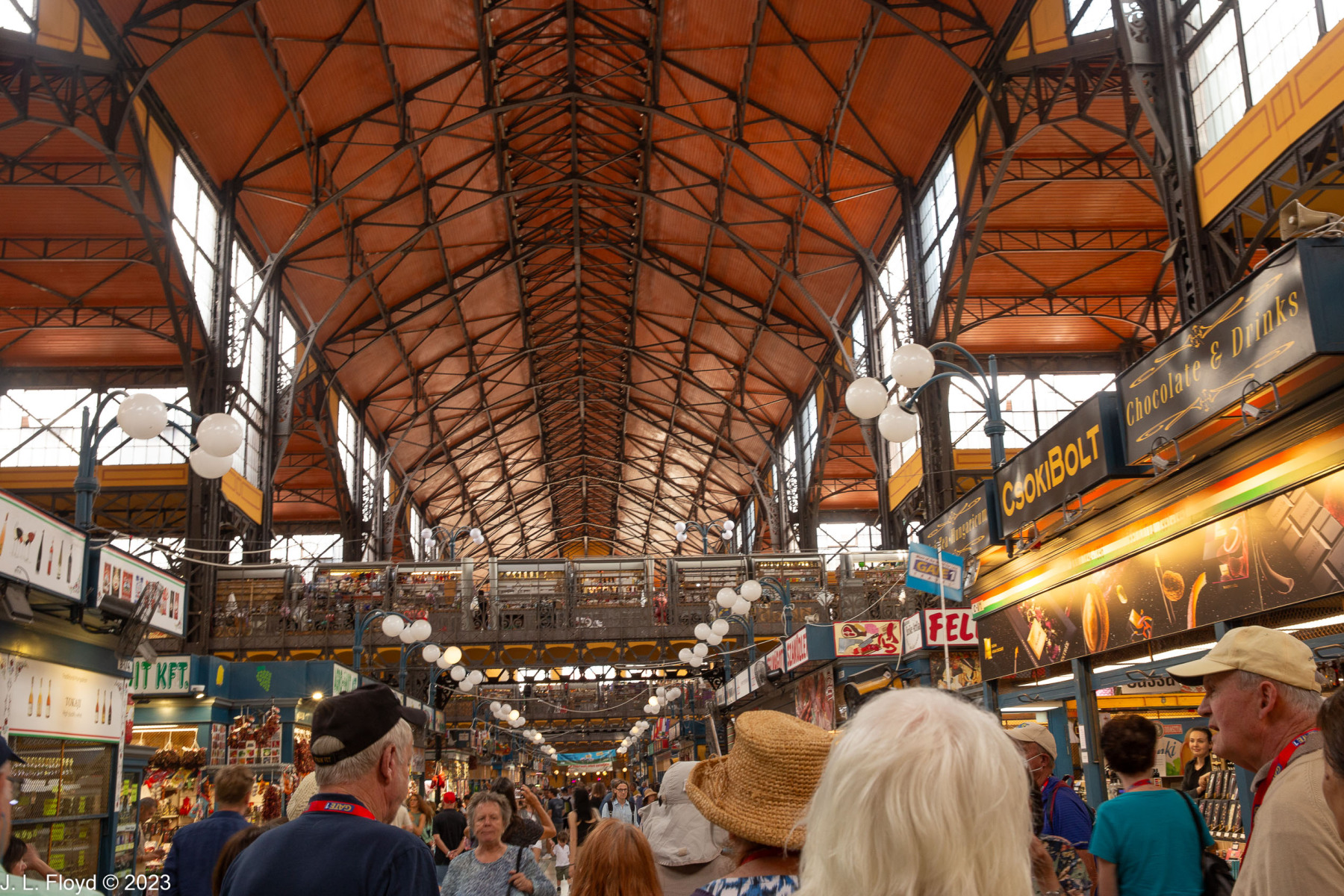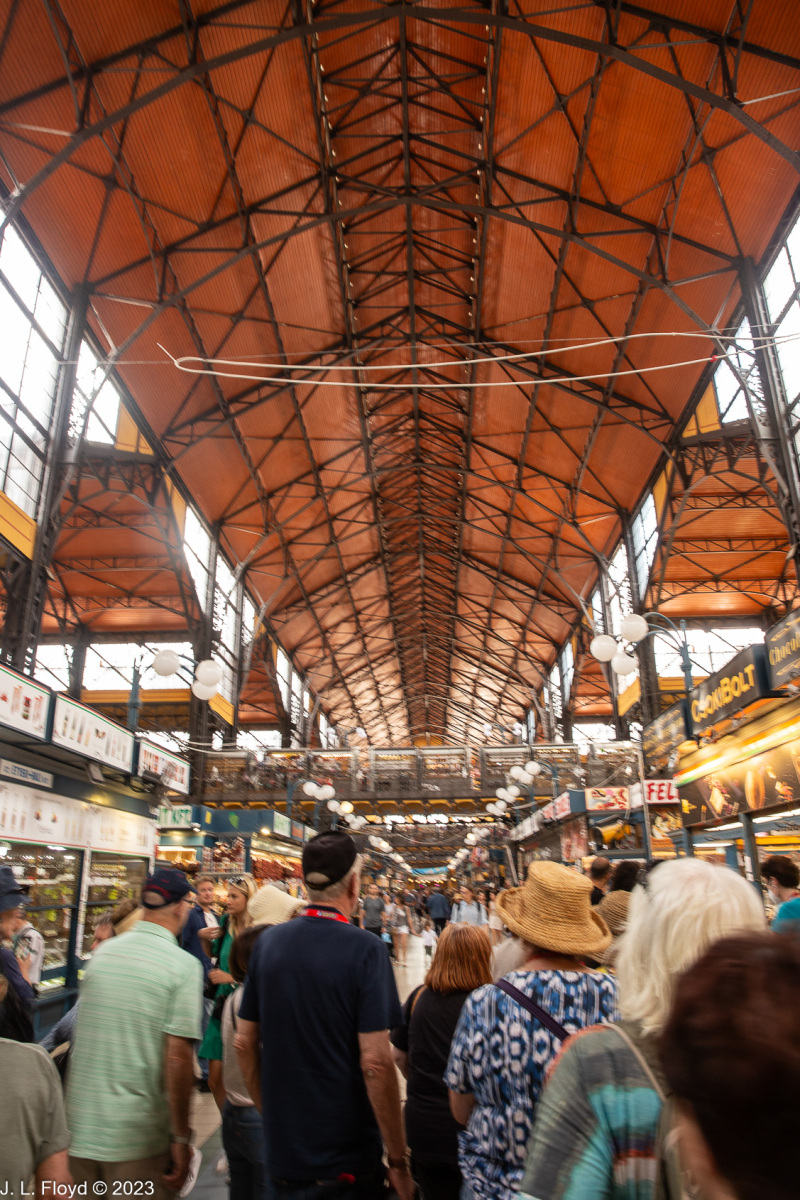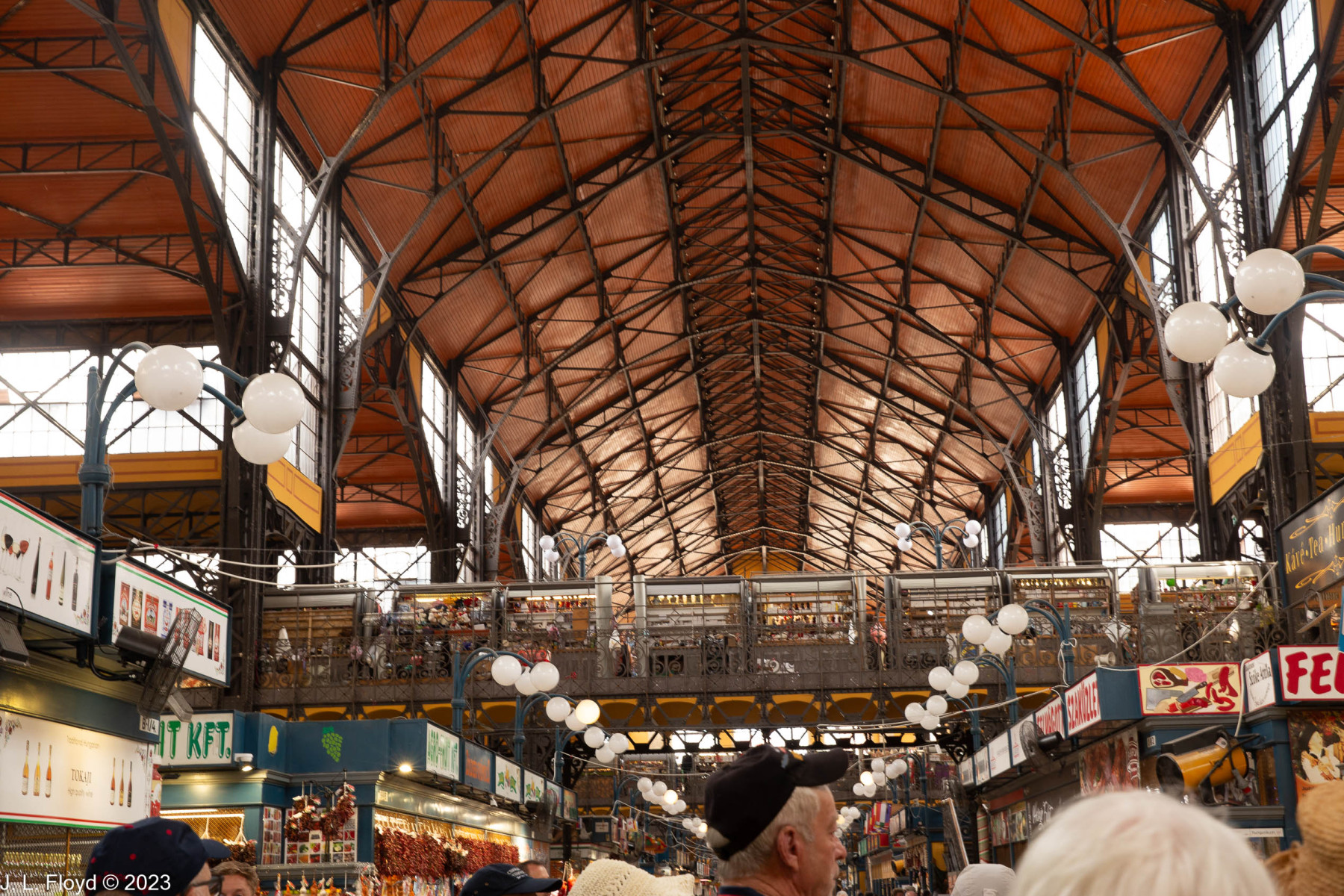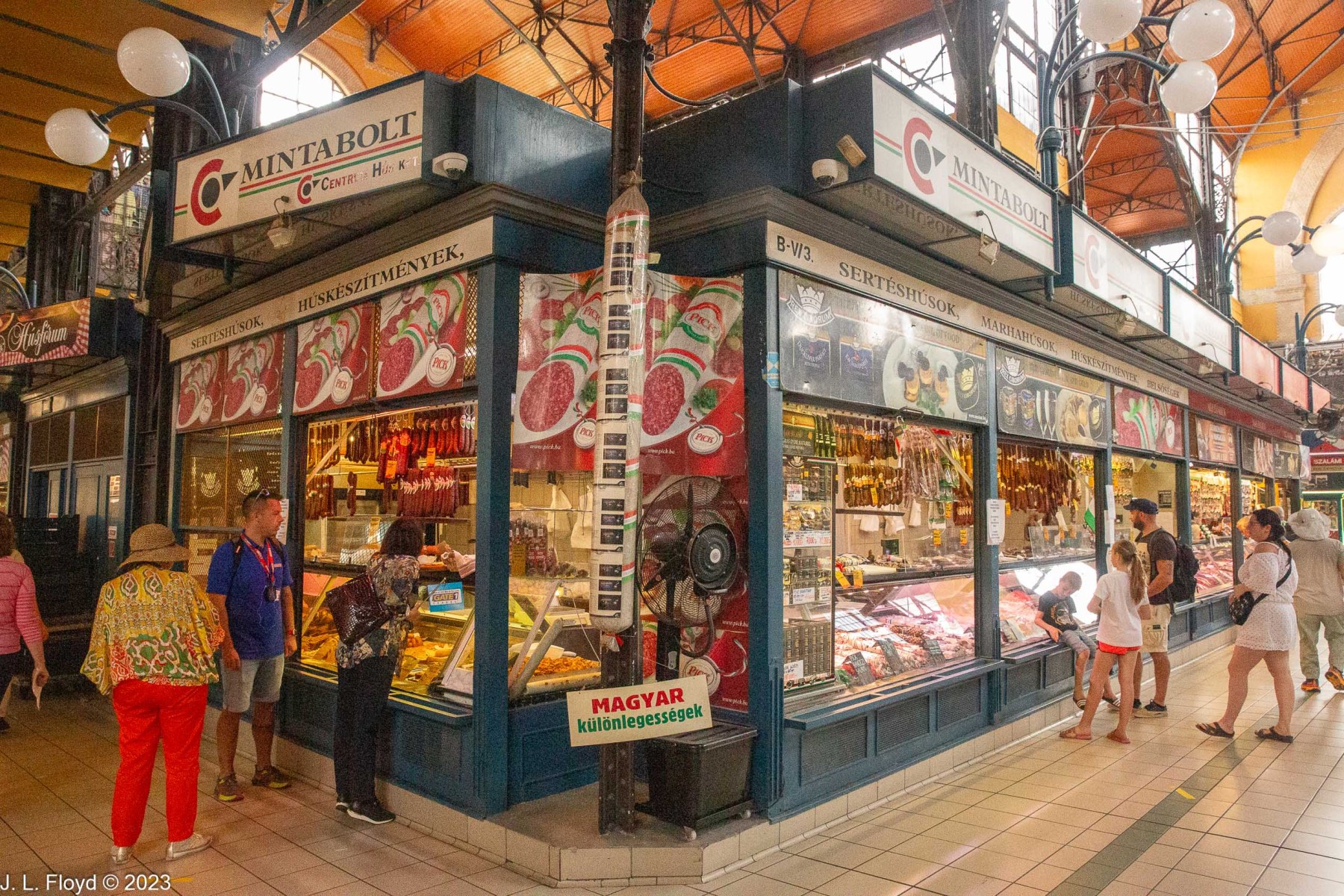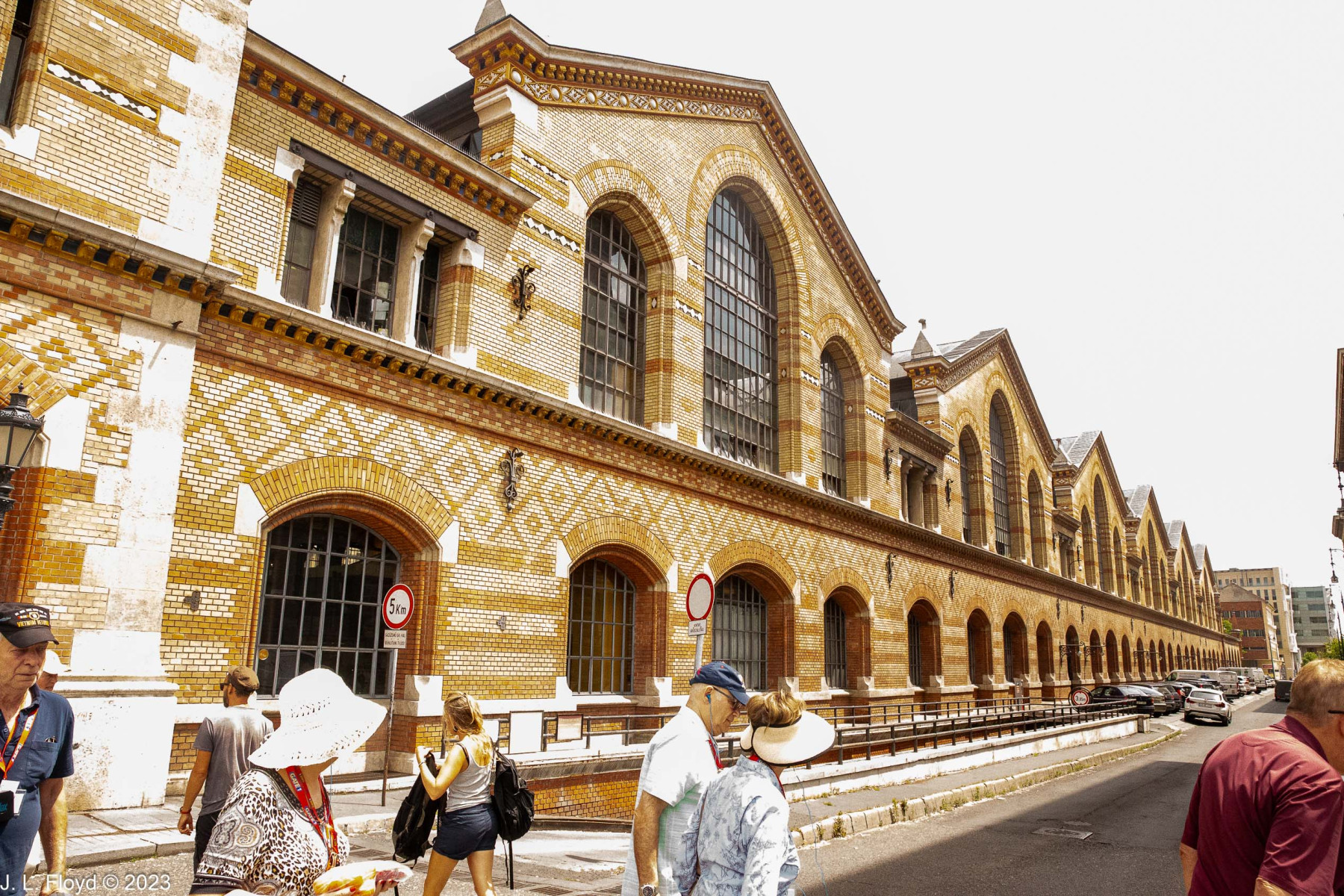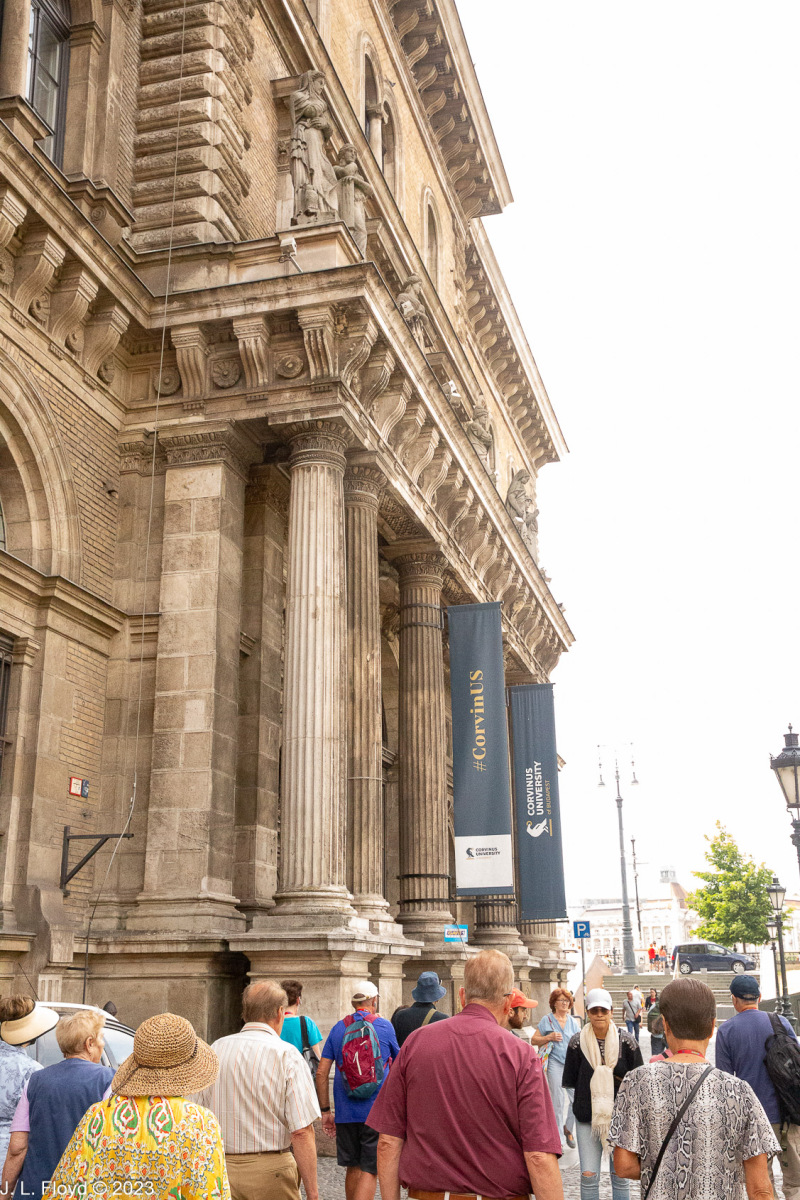The previous post, as you may recall, ended with me lost at the Visitors’ Center near the Hungarian Parliament, with no clue as to how to get back in touch with the tour group or find my way back to the Monarch Queen.
Before leaving the USA, I had made arrangements with our cell phone provider to ensure service abroad. I called the Gate1 emergency number, and the operator set the wheels in motion to rescue me, but that turned out not to be necessary. Sandie also had purchased travel service for her phone, and in a few minutes she called me and dispatched her chaperone, Nico, to fetch me from the Visitors’ Center.
It turned out that our tour guide had led the group to a strudel place at Liberty Square, southeast of Kossuth Square, where everyone was enjoying delicious strudels, except me. It was a bit of a hike to Liberty Square, but with Nico leading I made it there in time to enjoy a strudel myself. The downside was that I couldn’t stop to take many pictures on the way, and I missed some good shots.
It was a shame that I didn’t have time to explore much of Liberty Square, because it is one of the most historically interesting places in Budapest. Under Austrian rule it was the site of an army barracks and later a prison. Lajos Batthyány, first prime minister of the revolutionary government of Hungary in 1848, was executed there by the Austrians in 1849. The semi-autonomous Hungarian government created by the Compromise of 1867 tore down the barracks/prison in 1897 and converted the space into a public square.
The post-World War I Horthy regime erected a number of monuments in the square, mostly with the theme of lamenting Hungary’s losses of territory and population under the Treaty of Trianon. These of course were all swept away with the Soviet occupation at the end of World War II. The Soviets built an obelisk-type monument with a red star and hammer-and-sickle on top, and it is still there, although many Hungarians would like to see it gone.
Nowadays Liberty Square is a vibrant place with many different points of interest, often representing conflicting points of view. In 2013 a Memorial for Victims of the German Occupation was built on the south side of the square, depicting the Archangel Gabriel, representing Hungary, being attacked by an eagle representing Germany. Critics of the monument objects that it portrays Hungary as a passive victim of German aggression, ignoring the willing participation of Hungarians themselves in the war and the Holocaust. In protest, they created a Citizen’s Holocaust Memorial across the street from the official monument. Also known as the Living Memorial, it apparently consists of photos and personal objects of Holocaust victims, as well as placards, notes and other expressions of opinion.
But not all of the attractions of Liberty Square have political associations. Just to the south of the Citizen’s Holocaust Memorial is an “interactive” fountain, sometimes called the “Dancing Fountain,” consisting of a large square of pavement with holes that shoot water up at random intervals; the game is to see whether you can cross the square without getting wet. While I was watching, nobody succeeded. I didn’t try myself because I didn’t want to be walking around Budapest in soaking wet clothes.
Liberty Square also contains statues of U. S. presidents Ronald Reagan and George Bush. The U. S. Embassy stands on the east side of the square. I didn’t get that far, though, because the guide whisked us off to St. Stephen’s Basilica right after strudel time.
St. Stephen’s Basilica, though it is named after the first king of Hungary, who reigned a thousand years ago, is not a very old church. It was actually built between 1851 and 1905. The first architect designed it in neo-classical style, but he died in 1867, and his replacement switched to a neo-Renaissance style.
The basilica is set in a large square with plenty of open space around it. At the northwestern corner of the square there is a fountain with an obelisk, which turns out to be a monument to Stephen’s queen, Gizella, a Bavarian princess who married Stephen in 996 and is credited with a significant role in Christianizing the Hungarians. She is known in Hungarian as “Boldog Gizella”; “boldog” means “happy” in Hungarian but I think in this context it is better translated as “blessed.” She was the sister of Holy Roman Emperor Henry II. Deeply religious, she wanted to enter a convent, but when Prince Geza of Hungary asked for her hand for his son Istvan, she agreed to the marriage after being convinced that as Hungarian queen she would be in an excellent position to further the conversion of the Hungarian people to Christianity, which would please God far more than living in monastic seclusion.
Although St. Stephen’s is not the largest church in Hungary, it has the largest bell of any church in Hungary. The bell weighs 9250 kilograms, or 20,350 pounds; it was cast in Passau, Germany in 1990, transported to Budapest by riverboat, and hung in the southwest tower of St. Stephen’s, where it remains. By comparison, the Liberty Bell in Independence National Historic Park in Philadelphia, Pennsylvania, weighs 940 kilograms or 2,080 pounds. (The heaviest bell in the world, the Tsar-Kolokol in the Moscow Kremlin, cast in 1735, weighs 201,924 kg [445,166 pounds], but it broke soon after casting and has never rung.)
The great 1990 bell has had two predecessors in the southwest tower of the basilica. The first, known as St. George’s Bell, was hung in 1892 and was the largest bell in all of Austria-Hungary at the time, weighing 7735 kilograms (17,017 pounds). The military requisitioned it during the First World War, along with the other bells of St. Stephen’s, to be turned into cannons. It was not replaced until 1930, when a new bell, known as the Bell of Heroes or the Bell of St. Emeric (Latin form of the Hungarian name Imre), weighing 7945 kilograms (17,479 pounds), was installed. That bell was cast in Budapest by a Hungarian firm and was the pride of the nation; judging from its pictures, it was a very beautiful bell, a wonderful work of art. It lasted only 14 years before being hauled off by the Germans in 1944, presumably to be melted down for war production; at any rate it was never recovered.
Near St. Stephen’s we boarded our tour bus once again to make our final stop in Budapest – the Central Market Hall, or, as the Hungarians call it, the Nagy Vásárcsarnok.
Our Saturday morning tour of Pest had been billed as “A Taste of Budapest,” and other than our strudel stop at Liberty Square, the Central Market was where we indulged our palates.
The Central Market Hall, built in 1897, is a huge structure, 10,000 square meters in size, and is both a functioning market and a major tourist attraction. It has three floors filled with a myriad of small stalls, shops and eating places. The ground floor stalls offer produce, meats, pastries, candies, spices, and spirits. The top floor (first floor in Europe, second floor in North America) is a mezzanine hosting mainly cafes and souvenir shops. The basement features fish, butcher shops and pickled vegetables.
At the entrance to the market, we were greeted by a pleasant lady in traditional Hungarian costume, carrying a placard advertising the Restaurant Mesterek Konyh
Inside the market, our guide showed us to the Mintabolt Delicatessen, where we were regaled with an abundance of tasty free samples of bread, Hungarian sausage and cheese appetizers.
Our guide then turned us loose for a few minutes to explore the market further before meeting up to board the bus. But since we were slated to return to the ship, where lunch was waiting, there was no point in shopping for noshes; and I had already bought my souvenir T-shirts. In any case, Sandie and I were too exhausted from the morning’s exertions to take advantage of the opportunity to see more of the market, and we were barely able to stagger back to the bus.
After lunch we still had a few hours before the Monarch Queen was scheduled to depart, and I really wanted to see more of Budapest, but I was too worn out and most of the places I wanted to visit demanded too much time. I had already gotten lost once, and I didn’t think it was a good idea to miss the boat when it sailed. Which it did, promptly at 5 PM. But I am not done with Budapest yet; the departure was in itself a memorable experience, and I’ll deal with it in the next post.
